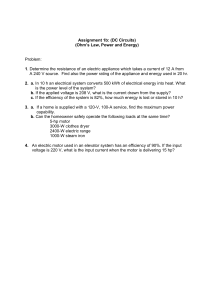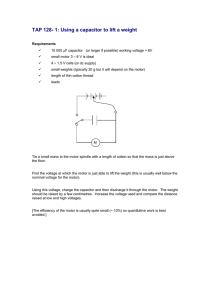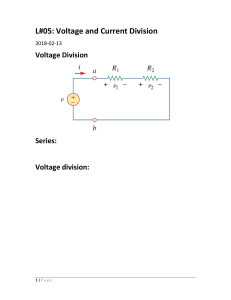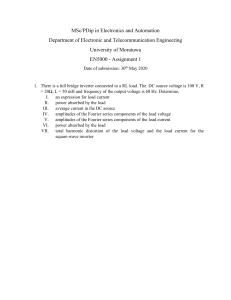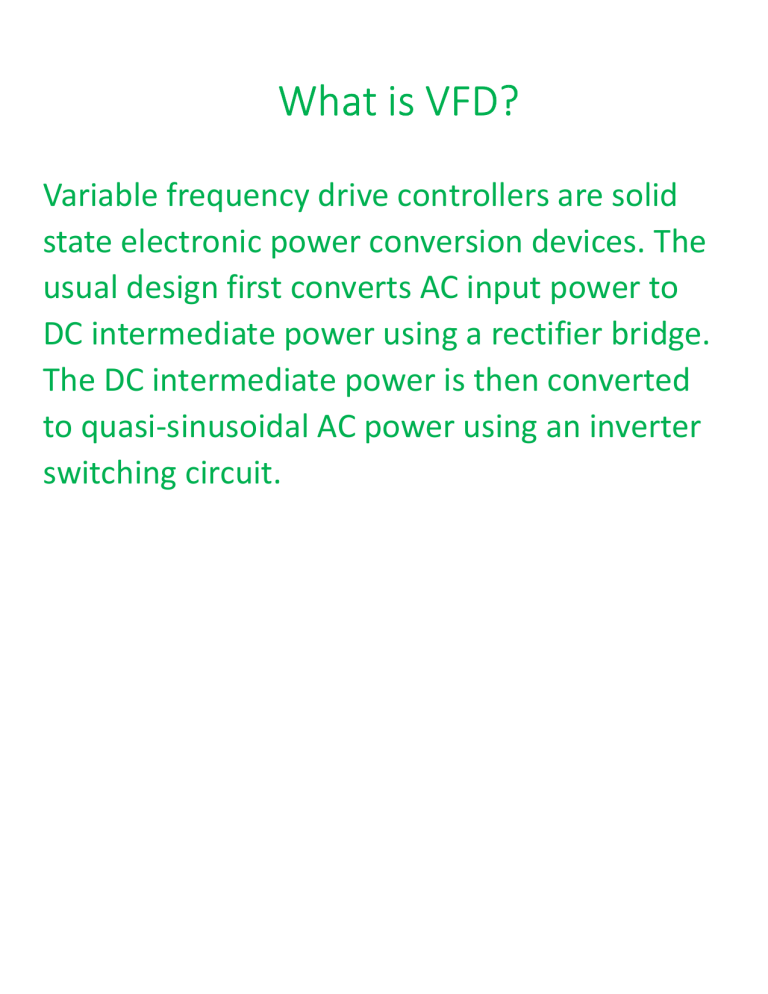
What is VFD? Variable frequency drive controllers are solid state electronic power conversion devices. The usual design first converts AC input power to DC intermediate power using a rectifier bridge. The DC intermediate power is then converted to quasi-sinusoidal AC power using an inverter switching circuit. A variable frequency drive system generally consists of an AC motor controller and operator interface PWM As new types of semiconductor switches have been introduced, they have promptly been applied to inverter circuits at all voltage and current ratings for which suitable devices are available. Currently, insulated gate bipolar transistors ( IGBTs ) are used in most VFD inverter circuits. The latest method used for adjusting the motor voltage is called pulse width modulation (PWM ). With PWM voltage control, the inverter switches are used to divide the quasi-sinusoidal output waveform into a series of narrow voltage pulses and modulate the width of pulses. PWM VFD Output voltage waveform. An embedded microprocessor governs the overall operation of the VFD controller. The main microprocessor programming is in firmware that is inaccessible to the VFD user. However, some degree of configuration programming and parameter adjustment is usually provided so that the user can customize the VFD controller to suit specific motor and driven equipment requirements. VFD OPERATION When a VFD starts a motor, it initially applies a low frequency and voltage to the motor. The starting frequency is typically 2 Hz or less. Starting at such a low frequency avoids the high inrush current that occurs when a motor is started by simply applying the utility ( mains ) voltage. When a VFD starts, the applied frequency and voltage are increased at a controlled rate or ramped up to accelerate the load without drawing excessive current. This starting method typically allows a motor to develop 150% of its rated torque while drawing only 150% of its rated current until the motor approaches full speed. A VFD can be adjusted to produce steady 150% starting torque from standstill right up to full speed while drawing only 150% current. With a VFD, the stopping sequence is just the opposite as the starting sequence. The frequency and voltage applied to the motor are ramped down at a controlled rate. When the frequency approaches zero, the motor is shut off. A small amount of braking torque is available to help decelerate the load a litter faster. Additional braking torque can be obtained by adding a braking circuit to dissipate the braking energy or return it to the power source. High peak voltages It can be experienced at the motor terminals especially when the distance between the inverter ( drive ) and the motor exceeds about 15 meters. This is typically caused by voltage doubling phenomenon of a transmission line having unequal line and load impedances. Motor terminal voltage can reach twice the DC bus voltage in long lead applications. When a characteristic load impedance is greater than the line impedance, then voltage (and current) is reflected from the load back toward the source ( inverter ).The absolute peak voltage is equal to the sum of the incident peak voltage travelling toward the motor plus the reflected peak voltage. Fast voltage rise times Fast voltage rise times of 1600V per micro second can be typical as the motor lead length exceeds just a few hundred feet. Voltage rise time is referred to as dv/dt. When the rise time is very fast the motor insulation system becomes stressed. Excessively high dv/dt can cause premature breakdown of standard motor insulation. Inverter duty motors typically have more phase-to-phase and slot insulation than standard duty motors AC when motors fail due to insulation stress caused by high peak voltage and fast voltage rise times ( high dv/dt ) they have common symptoms. Most failures of these types occur in the first turn as either a phase to phase short or phase to stator short. The highest voltage is seen by the first turn of the winding and due to motor inductance and winding capacitance of the motor, the peak voltage and dv/dt decay rapidly as the voltage travels through the winding. Normally the turn to turn voltage in a motor is quite low because there are many turns in the winding. However when the dv/dt is very high the voltage gradient between turns and between phase windings can be excessively high, resulting in premature breakdown of the motor insulation system and ultimately motor failure. This problem is most prevalent on higher system voltages (480 & 600 V) because the peak terminal voltage experienced often exceeds the insulation breakdown voltage rating of the motor. Solution Inverter duty Ac reactor – input side Ac reactor- Output side Dynamic braking

